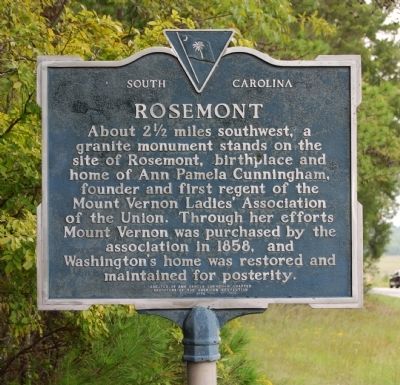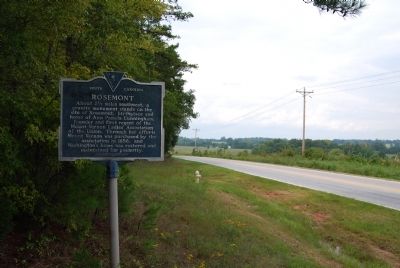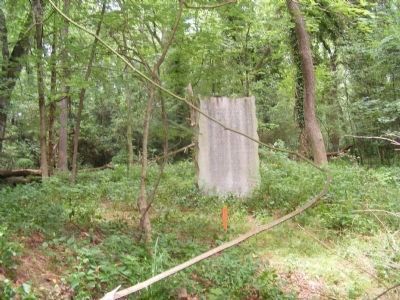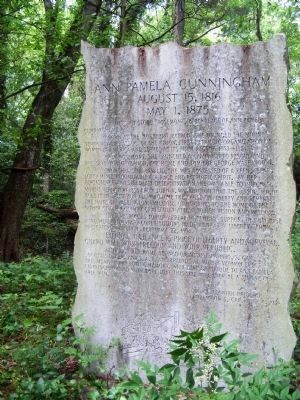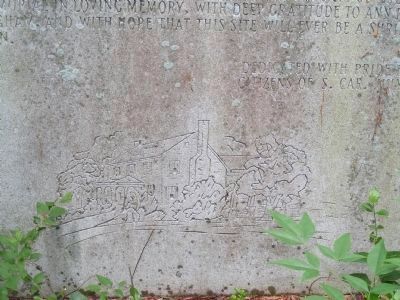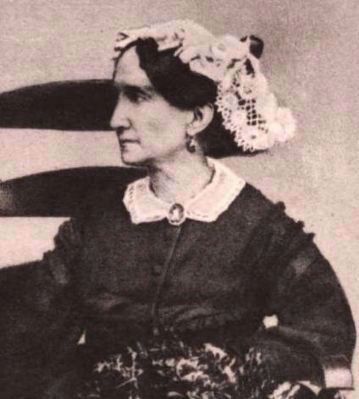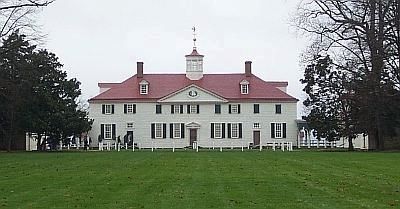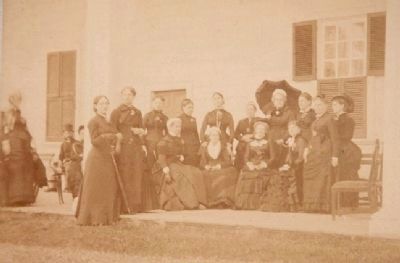Waterloo in Laurens County, South Carolina — The American South (South Atlantic)
Rosemont
Erected 1974 by Ann Pamela Cunningham Chapter, Daughters of the American Revolution. (Marker Number 30-2.)
Topics and series. This historical marker is listed in these topic lists: Fraternal or Sororal Organizations • Patriots & Patriotism • Women. In addition, it is included in the Daughters of the American Revolution series list. A significant historical year for this entry is 1858.
Location. 34° 19.462′ N, 82° 3.288′ W. Marker is in Waterloo, South Carolina, in Laurens County. Marker is on Greenwood Highway (US 221), on the right when traveling south. Marker is located at the intersection of Dillard Road and Greenwood Highway (SC Highway 221). Touch for map. Marker is in this post office area: Waterloo SC 29384, United States of America. Touch for directions.
Other nearby markers. At least 8 other markers are within 10 miles of this marker, measured as the crow flies. Cross Hill Confederate Monument (approx. 4.3 miles away); Francis Salvador (approx. 6.4 miles away); Rock Presbyterian Church (approx. 7.4 miles away); Siloam Baptist Church (approx. 8 miles away); Western Laurens Volunteer Fire Department (approx. 8˝ miles away); Tabernacle Cemetery (approx. 8.6 miles away); Park’s / Greenwood County (approx. 8.7 miles away); Emerald Farm (approx. 9.3 miles away).
Also see . . .
1. Rosemont Plantation. Rosemont, dating from ca. 1790 to 1930, is an excellent example of an Upland, or Piedmont, plantation associated with indigo, tobacco, and eventually cotton production. (Submitted on October 4, 2008, by Brian Scott of Anderson, South Carolina.)
2. Rosemont Plantation – Waterloo – Laurens County. Original plantation lands were located about 2½ miles south of the intersection of US 221 and SC Secondary Road 149. (Submitted on October 4, 2009, by Brian Scott of Anderson, South Carolina.)
3. National Womens History Museum: Ann Pamela Cunningham. Forerunner in historic preservation, Ann Pamela Cunningham was born in 1816, and was raised on a prosperous South Carolina plantation. (Submitted on October 4, 2009, by Brian Scott of Anderson, South Carolina.)
4. Ann Pamela Cunningham. Ann Pamela Cunningham (August 15, 1816 - May 1, 1875) is credited with saving George Washington's beloved home Mount Vernon from ruin and neglect. (Submitted on October 4, 2009, by Brian Scott of Anderson, South Carolina.)
5. George Washington's Mount Vernon Estates and Gardens. Official website of Mount Vernon. (Submitted on October 4, 2008, by Brian Scott of Anderson, South Carolina.)
6. Mount Vernon. Mount Vernon, located near Alexandria, Virginia, was the plantation home of the first President of the United States, George Washington. (Submitted on October 4, 2008, by Brian Scott of Anderson, South Carolina.)
Additional commentary.
1. About Rosemont
Rosemont Plantation, situated in Laurens County, South Carolina, is a Piedmont archaeological site dating from the late eighteenth through early twentieth century. It is the ancestral home of Ann Pamela Cunningham, founder of the Mount Vernon Ladies' Association of the Union. Originally encompassing several thousand acres, the nominated property, which incorporates the main settlement and gardens, is... Currently in woods, Rosemont includes both the below ground archaeological ruins of at least seven structures and the associated formal, landscaped gardens. The site maintains excellent integrity and the original,
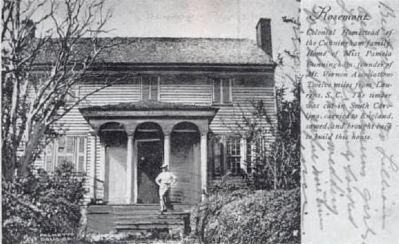
Postcard History Series: Laurens County by Laurens County Museum Association
3. Rosemont (Man Unknown)
Caption to the right reads: "Rosemont: colonial Homestead of the Cunningham family. Home of Miss Pamela Cunningham, founder of Mt. Vernon Association. Twelve miles from Laurens, S.C. The timber was cut in South Carolina, carried to England, sawed and brought back to build this house."
Rosemont is situated in southeastern Laurens County, South Carolina. The soils are classified as Hiawassee sandy clay loams to 2 to 6% slopes. Archaeological investigations have revealed an A horizon throughout the area which is at least 0.5 foot in depth. Surrounding Piedmont forests generally belong to the Oak-Hickory formation, and the potential natural vegetation is Oak-Hickory-Pine Forest, composed of medium tall to tall forests of broad leaf deciduous and needle leaf evergreen trees. The historic land use of the Rosemont area has greatly affected the extant vegetation of the property. While the surrounding tracts offer clear evidence of previous cultivation, second growth stands, and logging, the main plantation complex is more clearly affected by nearly 150 years of intensive human interaction producing an artificial biome of garden plants. It has been only in the past 60 to 75 years that the property has begun to revert to a natural ecological system. Today the Rosemont Plantation is characterized by a diverse range of hardwoods, such as the varnish tree, willow oak, hackberry, scarlet oak, post oak, eastern red cedar, red oak, black oak, ironwood, tulip poplar, shagbark hickory, black walnut, and dogwood.
Archival research indicates that the development of the plantation was begun sometime between 1750 and 1790. The plantation reached its zenith during the second quarter of the nineteenth century and the main house stood until it burned in 1930. Archaeological research has revealed ceramics which yield a mean ceramic date of 1837. Since the Rosemont main house is believed to have been occupied by 1790 and was burned in 1930, it yields a mean historical date of 1860. The ceramics from the main house excavations yield a mean date of 1852, while excavations at a nearby smokehouse have yielded a mean ceramic date of 1834. The earliest dates from the overall site and the smokehouse may indicate that some structures and site areas were abandoned sometime before the main house burned.
During its occupation from ca. 1790 until 1930, Rosemont Plantation was owned by the Cunningham family. The plantation is often linked with Ann Pamela Cunningham, who formed the organization in 1854 to purchase George Washington's Mount Vernon Plantation for the nation. During the eighteenth and early nineteenth century the plantation emphasized indigo production, gradually shifting to cotton in the nineteenth century. While the Civil War altered the labor base -- African American slavery -- the plantation continued to operate, primarily through tenancy, as a cotton plantation.
Rosemont represents a Piedmont plantation consisting of a main building complex and associated gardens. Through time at least 17 buildings or activity areas are known to have existed at the plantation, including the main house, the kitchen, the library, a smoke house, barn, grave yard, race grounds, a bridge, a loom house, a green house, various walks, the gardens, a spring, a chicken house, and a well. Archaeological investigations have identified the main house, two flankers (including the library), the well, smokehouse, walkways, and the garden area. The investigations not only recovered abundant artifacts (such as ceramics, bottle glass, nails, window glass, architectural hardware, personal items, furniture hardware, and clothing items), but also architectural remains of the structures (intact, below grade brick walls) and features (pits associated with the occupation of the site). Preservation of faunal remains is excellent, especially in the vicinity of the smokehouse. Archaeological remains were identified to a maximum depth of two feet, with the main house cellar, although elsewhere on the site the average depth of remains is approximately 0.8 foot. Archaeological remains were identified scattered over an area minimally 300 by 300 feet. The preservation of the site is remarkably good. Excavations revealed that erosion had a minimal impact on the site, and an A
horizon ranging from 0.5 to 0.8 foot in depth was uniformly present. While there is scarce documentary and archaeological evidence that the site has been disturbed by relic seekers immediately after the fire in 1930, Rosemont is otherwise in excellent condition. It has not been damaged by cultivation, development, or other, similar activities.
The main house was the central element around which the other plantation buildings and areas were constructed. The house was oriented approximately northeast-southwest...stood two buildings or dependencies, one of which (apparently the eastern) served initially as a school house, later as a library, and eventually as the living quarters for Ann Pamela Cunningham. The location of the kitchen (burned sometime after 1859)...from the house. At least three gardens are known to have existed at Rosemont: a vegetable or kitchen garden, a fruit garden or orchard, and an ornamental (flower and tree) garden. The vegetable garden...posts today. The location of the fruit orchard cannot be determined at present, although the trees may have been interspersed through the formal gardens, which were...
As previously mentioned, erosion has impacted Rosemont only slightly. Likewise, modern development, while reducing the overall size of the plantation, has not damaged the central settlement incorporated into this nomination. After the 1930 fire the settlement was abandoned and the ruins and gardens were gradually overtaken by the forest. The land, since then, has been used as a hunting preserve.
The most recent investigation of Rosemont Plantation has been undertaken by Historic Landscape and Garden Design (Columbia, S.C.) and Chicora Foundation, Inc. (Columbia, S.C.) for the Laurens County Historical Society. This work has included extensive archival research, mapping of the site core, limited archaeological survey and testing...and examination of the garden and landscape features associated with the site.
Statement of Significance
Rosemont, dating from ca. 1790 to 1930, is an excellent example of an Upland, or Piedmont, plantation associated with indigo, tobacco, and eventually cotton production. Archaeological research has revealed that the features and architectural remains associated with the plantation have good integrity and are capable of providing information on intra-site patterning, subsistence data, refuse disposal patterns, architecture and organization of the plantation, and the display of wealth by the plantation owner. An examination of the associated landscape features reveals that, in spite of over 100 years of abandonment, the gardens can still be traced, original plantings are present, walkways are preserved, and the gardening traditions of the period are evident.
In addition, Rosemont Plantation is intimately associated with Ann Pamela Cunningham, who was born at Rosemont in 1816, inherited Rosemont from her father, operated the plantation through the Civil War, and died at Rosemont in 1875. Ann Pamela Cunningham worked tirelessly to save George Washington's Mount Vernon plantation for the nation, organizing the first meeting to raise funds for the purchase, negotiating with the owners of Mount Vernon, serving as the first Regent of the Mount Vernon Ladies' Association of the Union, and overseeing the restoration of the house.
The History of Rosemont
The first documented owner of Rosemont Plantation was Patrick Cunningham, who apparently purchased land in the area during the mid-eighteenth century, although the exact date of the original purchase cannot be established. A Loyalist, Lt. Col. Patrick Cunningham played a relatively minor role in the Revolutionary War, although it was sufficient to cause his eventual banishment from South Carolina. Around 1785 Patrick returned to South Carolina and either began the construction of Rosemont, or continued construction halted by the war. Family papers suggest that he was a small slave holder even at this early date and that the plantation's cash crop was indigo. On his death in 1796 Patrick devised the lower half of his plantation, including his Rosemont dwelling, to his son,
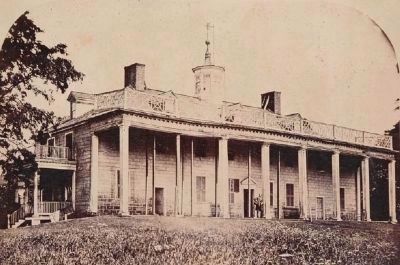
William L. Clements Library, University of Michigan, 1858
9. Mount Vernon at the Time of the Ladies Association Purchase
In 1856, the state of Virginia granted a charter to the association. The association raised $200,000 to buy the mansion and property in 1859. During the Civil War, both sides treated Mt. Vernon as if it were on neutral ground. Cunningham died in 1875.
It was under the ownership of Robert Cunningham that Rosemont's famous gardens were planted by his wife, Louisa Cunningham. Family correspondence and accounts of others familiar with the family attest to the beauty and constant work the gardens required. At least thirteen plants are mentioned in the historic accounts, including boxwoods, flowering apple (i.e., crab apple), Japanese quince, live oak, wisteria, evergreens, oleander, palmetto, rare French roses, wild Cherokee roses, and yellow rose trees.
Ann Pamela Cunningham was born at Rosemont in 1816 and although suffered a back injury as an adolescent, she appears to have been an active participant in the affairs of Rosemont by at least the early 1940s. In January 18470 Ann Pamela converted the library flanker into a house for herself, so she would not have to climb up and down stairs in the main house.
Ann Pamela began her efforts to purchase and preserve Mount Vernon for the nation in 1854, with the first organizational meeting at the Liberty Springs Presbyterian Church in Laurens County. The subscriptions promised at that meeting represented the first money contributed to the cause. Ann Pamela amazingly reached her goal in a few short years; the papers for the purchase of Mount Vernon from John Augustine Washington, Jr. were signed in December 1858, giving the Mount Vernon Ladies' Association of the Union control of the estate.
Robert Cunningham died at Rosemont in July 1859 and his will was to be the source of considerable family infighting and bitterness. Robert divided his land among Louisa, his wife; Ann Pamela, his daughter; and Robert, his son. His inventory included 155 slaves with a value of $108,900. To his wife he gave a life estate of 1000 acres "to be laid off so as to include my homestead," and 45 slaves. At her death the property would be equally divided between John and Ann Pamela. To Ann Pamela he gave the 1000 acre "Dry Fork" tract, although if she did not have children at her death, the tract would go to John. Finally, a clause provided that any additional lands would be divided between Louisa, John, and Ann Pamela.
This seemingly straightforward division was complicated by Robert Cunningham having sold off the Dry Fork tract prior to his death. consequently, in January 1860 the Cunninghams filed a deed to partition the estate of Robert Cunningham. Ann Pamela, through this partition, eventually received a portion of Rosemont Plantation, although she complained that her property was the "thinnest, & most valueless of the whole Estate".
Regardless, Ann
Pamela was actively involved in both the continued operation of Mount Vernon and the daily activities of plantation life at Rosemont. In fact, she stayed at the plantation throughout the Civil War, attempting to maintain its productivity, while corresponding with Mount Vernon. The Rosemont gardens, originally created by Louisa Cunningham, were likely less well maintained and began their slow descent.
The post-bellum period, as elsewhere in South Carolina, ushered in a new economy. At Rosemont there is evidence of several different varieties of tenancy. With Louisa Cunningham's death in 1873, Ann Pamela continued her efforts to make Rosemont profitable, despite inefficient and untrustworthy overseers. With Louisa Cunningham's death, the Rosemont property was again divided between John and Ann Pamela Cunningham.
Finally the outright owner of the Rosemont Plantation, Ann Pamela was unable to enjoy the home of her ancestors. She died only three months later, on May 1, 1875. The Rosemont property, with Ann Pamela's death, was again embroiled in a dispute among the family members. Eventually the Rosemont Plantation home was partitioned to John Cunningham, Ann Pamela's brother.
The property continued to be held by various Cunninghams into the twentieth century. During the early twentieth century Hugh Banks Cunningham (a son of Charles Henry Banks, Sr. and Louisa Bird Cunningham, daughter of John Cunningham) moved to Rosemont and began an ambitious program of renovation and restoration, much of which was apparently successful. Unfortunately, a fire of mysterious origin destroyed the Rosemont mansion on August 19, 1930, killing Hugh Cunningham ("Many Priceless Relics Destroyed When Historic Mansion Burned," The State, Columbia, S.C., August 24, 1930).
The history of Rosemont Plantation closely parallels the history and development of the upcountry of South Carolina. When there were economic booms, they are reflected in the writings and actions of the Rosemont owners. When there were hard times, the impacts were quickly felt at Rosemont. Through all of the social and economic turmoil, the owners of Rosemont continued to fight not only the lost cause of slavery, but also themselves.
It was not until the early nineteenth century that Rosemont became known for its grand gardens and imposing house. Louisa, the wife of Robert Cunningham, appears to have been the moving force behind the modifications of the Rosemont landscape and the gardens reached their zenith between 1820 and •1850. With Robert Cunningham's death in 1859 and the ensuing Civil War, the plantation, as well as the Cunningham family, fell on hard times. This is reflected both in the gradual deterioration of the plantation and the increased in-fighting among the family. There is no real evidence that the gardens continued in any formal sense after the Civil War, and it is likely that the house received only minimal maintenance.
There is evidence that the rather diversified agricultural base of Rosemont in the early antebellum period had shifted almost entirely to cash cropping in the post-bellum period, a trend seen throughout much of the South Carolina Piedmont. The history of the plantation through this period is less well known; although there is evidence that Rosemont continued to be marginally productive through Hugh Banks Cunningham's life. By the mid-twentieth century the Rosemont tract, like others in the area, had been converted to timber and held value only for that timber, coupled with nostalgia for the "old days."
The Historic Context and Significance of Rosemont
Piedmont plantations have attracted periodic historical attention. Some historians, such as Rosser Taylor present a somewhat stereotypical view of the upcountry as a rough area with few major "seats" or plantation dwellings. others, such as Lacy Ford are beginning to unravel the social dichotomy of the region. Unfortunately, the archaeological contribution to our understanding of Piedmont plantations is paltry. After nearly two decades of archaeological research in other areas of South Carolina, much emphasizing plantation archaeology, the Piedmont remains largely unexplored.
Questions comparing the wealth of the Piedmont short staple cotton plantations with sea island cotton plantations, or comparing the wide range of Piedmont social fabric, or exploring the nature of Piedmont slavery, have not been examined -- and in most cases have not even been formulated.
Rosemont may represent a "typical" Piedmont plantation. While land acquisitions by Patrick Cunningham may have begun before the American Revolution, it was only after the war that the property was integrated into the plantation economy in a meaningful way. The construction of the Rosemont house, singled out by Taylor as an example of the rare elegance of the Piedmont, was completed at least by the 1790s. The production of tobacco, indigo, a variety of grain crops, hogs, sheep, and cattle reveals that Rosemont was participating in the diversified economy of many larger Piedmont plantations. It was only in the first quarter of the nineteenth century that cotton began to rule the Rosemont economy, and even then its monarchy was tenuous, constantly sharing power with subsistence crops.
Rosemont is associated with a person significant in our past, Ann Pamela Cunningham, first Regent of the Mount Vernon Ladies' Association of the Union. In many ways, Louisa Cunningham is also a person noteworthy in our history. Ann Pamela acknowledged and gave credit to her mother for convincing her of the need to save Mount Vernon. Likewise, Ann Pamela certainly was influenced by the tradition and importance of landscape gardening at Rosemont, enough to promote and restore not only George Washington's mansion, but also his gardens.
The antebellum period at Rosemont was marked by the design and elaboration of the gardens. Little scholarly research has been conducted on historic gardens in South Carolina. Some few lowcountry plantation gardens (such as Middleton Place) have received investigation, but upcountry plantation gardens have been neglected. The problem lies not only in the interests of scholarly pursuit, but also in the nature of landscapes. Designed landscapes grow, change dramatically, and tend to disappear without care over the passage of time. With time and development, few upcountry plantations, much less their gardens exist.
Rosemont is an excellent example of landscape gardening in the upcountry during the nineteenth century. First, Rosemont is perhaps one of the best known Piedmont plantation because of the current research, and its association with Ann Pamela Cunningham, founder of the movement to save George Washington's home in the 1850s. Secondly, there is much to be found in primary historic resource materials about the family and its gardening activities at Rosemont. Lastly, the site exhibits considerable integrity in landscape gardening intent: there are elements of the design still intact (such as the boxwood avenues leading up to the front of the former house) and there are non-indigenous trees, shrubs, and ground covers on the site (some original species, some descendants of these).
The tradition of landscape gardening began at Rosemont with Louisa Bird Cunningham. South Carolina Governor Benjamin Perry, a frequent visitor to the plantation in its days of beauty, wrote of Louisa Cunningham in 1974: "Her passion for flowers was unsurpassed; she collected them from all parts of the world. Her flowers and shrubbery covered acres of ground around "Rose Mount"...She had the honor of being the pioneer florist in the up-country."
Perry also mentioned in this account that Louisa, shortly after her 1814 marriage to Robert, had received a collection of rare flowers from Mount Vernon, sent by Judge Bushrod Washington. According to Perry, Mrs. Cunningham's "pioneer garden and shrubbery [were] laid off with great taste and artistic skill".
From this account and other primary resource materials, the significance of landscape gardening at this upcountry plantation can be documented. Family letters, beginning about 1833, show the garden and plantation at its zenith. Valuable information on upcountry antebellum plantation gardening is given. Again, these findings are especially enlightening since research in the area of landscape garden history in the Southeast is sparse. Findings at Rosemont include:
• the design elements of the garden - in front of the house "a center bed and corner beds" of boxwood, "roses planted in a hedge each side of the avenue next the fence," "library - and back of it I have laid out in a handsome flower parterre".
• gardening techniques of the period - including the construction of fences, "running of paling" to protect the garden from "fowls" and a greenhouse suggested by Joel Poinsett.
• ornamental and exotic plants that were grown, including rose and tulip and "Euonymus area," "Deoclea glycinoides," and "Thrift & Pompone Chrysanthemum".
• gardening traditions of the period - "collecting" plants from Mrs. Seabrook of Edisto Island.
Today Rosemont still evidences signs of its cultivation -- old magnolias tower in the forest and avenues of tree boxwoods reside in the woods. Parts of the symmetrical, formal design can be discerned, although some boxwood have been robbed out of the pattern over the years. Other non-indigenous vegetation such as crepe myrtle, osage orange, varnish tree, Empress tree, and Japanese cryptomeria are visible (see attached site map). Except for the crepe myrtle and cryptomeria, these are not the original specimens present during the antebellum, but they represent the descendants of those original plants and are not found in other parts of the adjacent forest. Even dead plant material (such as cedar tree stumps marking an avenue of cedars from the house toward the river) provide significant evidence of the garden design.
Consequently, the garden at Rosemont embodied distinctive characteristics of the style of gardening popular during the early to mid-nineteenth century. Descriptions of the garden during this period portray the beauty and grace of arrangement. Louisa Cunningham's landscape efforts may be considered the work of a master gardener.
According to family tradition, Louisa Cunningham visited Mount Vernon during Bushrod Washington's tenure. She would have seen George Washington's landscape, the eighteenth century English landscape tradition transferred to this American plantation. She would have seen a mixture of the formal (boxwood enclosed flower and kitchen gardens) with the natural landscape (the deer park). Also Louisa came to South Carolina from a plantation in Georgia, a state which has a long tradition of patterned boxwood gardens or "parterres of cut-work" sited in front and to the side of the main plantation house. Louisa also travelled to the north (Philadelphia) at regular intervals, providing additional exposure to gardening trends.
Taking these experiences and blending them together, Louisa Cunningham imposed order on the natural upcountry landscape. The design existing today (to the northeast and east of the former house) is formal and accomplished in the old school of design (English, French, and Dutch influences before the eighteenth century). There are four approximately symmetrical lines of boxwood accented by magnolias. The middle pair of boxwood probably formed a carriage entrance to the front entry garden. The three circles or patterns of English boxwood that served as the entry garden can no longer be identified.
There is mention in secondary historic resources of a park removed from the house (i.e., "Rosemont, Built in 1787, Is In Excellent State of Repair, A Shrine of Cunninghams," Index Journal, Greenwood, S.C., August 19, 1928), which might have (followed the newer design traditions of the landscape gardeners of the nineteenth century, John Loudon and Andrew J. Downing. This park, although not described, would have been in a more natural style, with winding paths through the landscape. This park, however, has disappeared through the flooding of the Saluda River and associated lake side development. Certainly, Rosemont could have been a combination of styles suited to the plantation's distinctive situation and- the designer's preference. Many gardens presented a mix of both the "ancient" and "natural or romantic" styles.
This site can convey valuable information 'and can add to our understanding of landscape gardening during the nineteenth century in the southeast and South Carolina. Rosemont offers the potential to uncover further information on nineteenth century plantation life, including upcountry gardening. It is remarkable that this landscape still possesses significant elements of integrity of design and plant materials after more than 160 years, and especially after over sixty years since the loss of the main house. Most upcountry plantations have disappeared with their attendant landscapes, such as in the case of James Calhoun's Millwood Plantation in Abbeville County; or plantation gardens have been so changed or added to that the context of the original is entirely altered, such as with Governor Gist's Union County Rose Hill Plantation.
The archaeological investigations conducted at the site reveal clearly the significance of Rosemont. In spite of scavenging and the aggressive Piedmont erosion, the remains at the site exhibit clear integrity, with the presence of features and intact architectural remains. The artifacts recovered from the site yield a mean ceramic date almost exactly the same as the mean historic date for the plantation (the mean ceramic date for the main house is 1852, compared to a mean historic date of 1860; the mean ceramic date for the entire site area is 1837). And, while twentieth century artifacts may seem to overwhelm the colonial and early nineteenth century specimens, this is only an appearance based on the natural increase in material items during the twentieth century.
The examination of the artifact pattern at Rosemont reveals a similarity with other Piedmont sites, although the similar sites tend toward yeoman or tenant occupations. Without additional archaeological investigations it is impossible to determine if the artifact patterns at Rosemont are typical of Piedmont plantations, represent the long period of post-bellum occupation, or have been affected by other, yet unrecognized, processes.
The artifacts from Rosemont, while perhaps not fitting into a pattern easily recognized at this stage of research, do suggest the wealth and prosperity of the Cunningham family over much of its existence. Creamware is found, rather than lead glazed slipwares, and transfer printed patterns are common during the later periods. other artifacts, such as personal items, architectural detailing, and clothing objects, provide some sense of the planter elite during the antebellum period.
Future archaeological work at Rosemont offers the potential to explore a variety of significant research questions:
• At the main house additional archaeological investigations can document the architectural detailing of the structure, its precise location, and the artifacts associated with its occupants. Such work can provide additional clues on its construction and expansion dates.
• At the other structures known to exist on the Rosemont property, such as the smokehouse, flankers, and garden structures, additional archaeological investigations can identify functional uses, explore construction, and examine evidence of status. Of particular interest may be the library, once the temporary home of Ann Pamela Cunningham. The smokehouse is of interest given the quantity of faunal remains present and its potential to address subsistence questions.
• In the yard areas archaeological investigations can examine the refuse disposal practices present at a high status, carefully-landscaped Piedmont plantation. In addition, this work may provide additional information on the Rosemont kitchen.
• The gardens offer an opportunity to examine the placement and layout of paths and planting areas.
Broad research questions include the economics of the Piedmont Rosemont Plantation as compared to other (i.e., Sea Island) plantations, the development of the plantation in the Colonial period, and the lifestyles of the African-American slaves present at Rosemont. (Source: National Register nomination form.)
— Submitted October 4, 2009, by Brian Scott of Anderson, South Carolina.
2. About the granite monument to Ann Pamela Cunningham
The granite monument dedicated to Ann Pamela Cunningham, seen in pictures above, reads:
August 15, 1816
May 1, 1875
On this spot stood “Rosemont”, birthplace of Ann Pamela Cunningham.
Known as the “Southern Matron’ she founded the Mount Vernon Ladies Assoc. of the Union, first patriotic organization of women in America and served as its first regent, 1853 – 1874.
From Rosemont, she launched a campaign to rescue and preserve Mount Vernon, the home and tomb of George Washington.
Though a semi-invalid, she was possessed of a keen, clear, lofty mind, indomitable courage and patriotic spirit. By her persistence and steadfast determination she was able to purchase Mount Vernon in 1858 from John A. Washington that the Assoc. might hold it in trust for all who love the cause of liberty and revere the name of Washington. Millions of pilgrims to the home of the father of our country gratefully attest to her vision and wisdom.
First responses to her appeal for public support of purchase fund were voluntary contributions made at nearby Liberty Spring Presbyterian Church, February 22, 1854.
Eternal vigilance is price of liberty and survival. Guard well your freedom and your republic.
Although her home burned on August 19, 1930, S. CAR. Societies D.A.R. and S.A.R. and friends at Mount Vernon erect this memorial in loving memory, with deep gratitude to Ann Pamela Cunningham and with hope that this site will ever be a shrine of free men.
Dedicated with pride by citizens of S. Car. July 4, 1959.
— Submitted June 7, 2010.
Additional keywords. N34° 19.462' W82° 03.288'
Credits. This page was last revised on December 14, 2019. It was originally submitted on October 4, 2008, by Brian Scott of Anderson, South Carolina. This page has been viewed 4,320 times since then and 121 times this year. Last updated on June 27, 2014, by John Huoni of Greenwood, South Carolina. Photos: 1, 2. submitted on October 4, 2008, by Brian Scott of Anderson, South Carolina. 3. submitted on October 4, 2009, by Brian Scott of Anderson, South Carolina. 4, 5, 6. submitted on May 30, 2010, by Theresa Garrett of Waterloo, South Carolina. 7, 8, 9, 10, 11. submitted on October 4, 2009, by Brian Scott of Anderson, South Carolina. • Bill Pfingsten was the editor who published this page.
